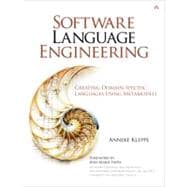
Anneke Kleppe has over twenty years of experience in IT. She started her career in telecommunications and then worked as an independent consultant with her own company, Klasse Objecten. She has coached and trained employees of companies working with MDA, OCL, and UML. Currently, she is a consultant at Capgemini and is responsible for the introduction of domain-specific languages for various clients.
| Background Information | p. xvii |
| Preface | p. xix |
| Foreword | p. xxvi |
| Why Software Language Engineering? | p. 1 |
| An Increasing Number of Languages | p. 2 |
| Software Languages | p. 3 |
| The Changing Nature of Software Languages | p. 4 |
| Graphical versus Textual Languages | p. 5 |
| Multiple Syntaxes | p. 6 |
| The Complexity Crisis | p. 7 |
| What We Can Learn From | p. 8 |
| Natural-Language Studies | p. 9 |
| Traditional Language Theory | p. 10 |
| Graph Theory | p. 10 |
| Summary | p. 12 |
| Roles in Language Engineering | p. 15 |
| Different Processes, Different Actors | p. 15 |
| The Language User | p. 16 |
| Tool Set of the Language User | p. 17 |
| The Language Engineer | p. 19 |
| Tool Set for the Language Engineer | p. 19 |
| Tool Generators | p. 20 |
| Summary | p. 21 |
| Languages and Mograms | p. 23 |
| What Is a Language? | p. 23 |
| Mogram, or Linguistic Utterance | p. 24 |
| Primitive Language Elements and Libraries | p. 26 |
| Abstraction Levels and Expressiveness | p. 27 |
| Abstract versus Incomplete | p. 29 |
| Raising the Level of Abstraction | p. 29 |
| Growing Business Expectations | p. 31 |
| Languages and Abstraction Levels | p. 32 |
| Domain-Specific Languages | p. 33 |
| Domain-Specific versus General Languages | p. 33 |
| Domain Experts versus Computer Experts | p. 33 |
| Large User Group versus Small User Group | p. 34 |
| Horizontal DSLs versus Vertical DSLs | p. 34 |
| DSLs versus Frameworks and APIsp37 | |
| DSLs as Software Languages | p. 37 |
| Summary | p. 38 |
| Elements of a Language Specification | p. 39 |
| Language Specification | p. 39 |
| Forms of a Mogra | p. 40 |
| Parts | p. 41 |
| Creation Process | p. 42 |
| An Example | p. 43 |
| Formalisms to Specify Languages | p. 47 |
| Context-Free Grammars | p. 47 |
| Attributed Grammars | p. 49 |
| Graph Grammars | p. 51 |
| UML Profiling | p. 52 |
| Metamodeling | p. 53 |
| Formalism of Choice | p. 53 |
| Summary 54 Cha | |
| Table of Contents provided by Publisher. All Rights Reserved. |
The New copy of this book will include any supplemental materials advertised. Please check the title of the book to determine if it should include any access cards, study guides, lab manuals, CDs, etc.
The Used, Rental and eBook copies of this book are not guaranteed to include any supplemental materials. Typically, only the book itself is included. This is true even if the title states it includes any access cards, study guides, lab manuals, CDs, etc.